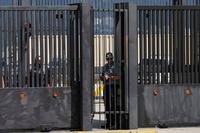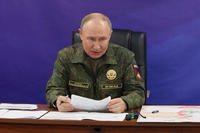The case of Army 1st Lt. Nathan B. Baskind was unique in the annals of the more than 73,000 U.S. service members still listed as missing in action from World War II, and the case had long gone cold.
The case of Army 1st Lt. Nathan B. Baskind was unique in the annals of the more than 73,000 U.S. service members still listed as missing in action from World War II, and the case had long gone cold.
His name was carved into a wall in the Garden of the Missing in the Normandy American Cemetery overlooking the invasion beaches along with more than 1,500 other American troops whose bodies were never identified or recovered after the landings and related operations.
Read Next: Texas Congressman Won't Stop Wearing Combat Infantryman Badge that Was Revoked
Through an extraordinary effort by Jewish advocates, his family, the Defense Department and other nations, Baskind's remains were found and will finally be laid to rest in France this week, eight decades after his death in the war.
The initial efforts to recover Baskind's remains after the war were fruitless, and the case was forgotten until Eric Feinstein, a genealogist in New Jersey working with the nonprofit group Operation Benjamin, came across Baskind's name in German war records. "You should check it out," Feinstein told Shalom Lamm, co-founder and chief historian of Operation Benjamin.
Lamm immediately knew that the chance of finding and identifying Baskind's remains was the longest of long shots. Operation Benjamin was formed as a 501(c)(3) nonprofit in 2020 with the mission of identifying Jewish war veterans who were mistakenly buried under Latin crosses and replacing the grave marker with the Star of David, but the group had no experience with recovering and identifying remains.

But through a combination of happenstance, guesswork, persistence, painstaking research, and a push in the right direction from the German ambassador to Israel, Operation Benjamin was able to solve the mystery of what had happened in the war to a 28-year-old guy who had worked in his family's wallpaper business back in Pittsburgh.
Baskind was a platoon commander with Company C, 899th Tank Destroyer Battalion, and was in charge of getting four M10 tank destroyers -- modified Sherman tanks -- ashore on Utah Beach in the D-Day landings of June 6, 1944. It was no small feat. At least 27 tanks sank before reaching the beaches during the landings.
Ambush on Cherbourg Road
Baskind was later in a jeep with a driver ahead of his M10s on a scouting mission in the opening stages of the battle for the port city of Cherbourg, about 65 miles northwest of the Normandy beaches, when they ran into a German ambush.
The soldier with Baskind was wounded but "escaped the firefight and made his way back to the main U.S. force, believing Baskind was killed in the attack. Several attempts were made to retrieve Baskind's body from the ambush point, but they could not locate his remains," according to an account by the Defense POW/MIA Accounting Agency, or DPAA.
After the war, the American Graves Registration Command found German files showing that Baskind was captured and taken to a Luftwaffe field hospital for German air force personnel near Cherbourg, where he died on June 23, 1944. He was buried in a military cemetery in Cherbourg with more than 20 Germans who had been killed in action.
Then in 1957, the Volksbund, the German War Graves Commission, notified the U.S. that an identification tag for Baskind and a shirt with a first lieutenant's rank and tank destroyer insignia had been found while disinterring the Cherbourg military cemetery for the remains of 24 German troops.
But the remains were commingled, and the German investigators were unable to separate them with the forensic means available at the time. Instead, the remains were put in several burial pouches and reburied in the Marigny German War Cemetery, 40 miles south of Cherbourg, which is the gravesite for more than 11,000 German troops killed in France.
"Subsequent attempts to identify the remains of 1st Lt. Baskind by U.S. and German investigators were not successful," the DPAA said, but Operation Benjamin and the Lawrence P. Gordon Foundation pressed for another search in the Marigny cemetery.
In a phone interview from Israel, Lamm of Operation Benjamin said he took the plea to Steffen Seibert, the German ambassador to Israel, whose response was, "If we, the German government, the German military, if we can return this soldier to the U.S., what an amazing story that would be."
In what Lamm described as an "amazing moment of moral clarity," Seibert contacted retired German Brig. Gen. Dirk Backen, now secretary general of the Volksbund, who gave the go-ahead for a search in Marigny for Baskind's remains with the approvals of the French, German and U.S. governments.
Finding Uncle Nate
The search and disinterments in December were bogged down, but Samantha Baskind, the great-niece of Nathan Baskind, recalled that "Uncle Nate" was a short man, maybe 5-foot-4 or 5-foot-5, and remains that might fit a man of short stature were sent back to the U.S. for analysis and DNA matching.
Jordan Karsten, a University of Wisconsin Oshkosh anthropologist known for his work with police on cold cases, was part of a private team that matched the remains with DNA samples from the Baskind family. The Armed Forces Medical Examiner System later reviewed the findings of the private team and confirmed the DNA matches, the DPAA said.
On May 8, the DPAA announced that Baskind, a recipient of the Purple Heart, had been accounted for and was no longer among those missing in action.
On May 28, his remains were returned to U.S. custody by a German military honor guard to an honor guard of the U.S. 21st Theater Sustainment Command in a dignified transfer ceremony at Landstuhl Regional Medical Center in Germany.
In a release following the dignified transfer, the Volksbund said that "80 years after the Allied landings and the beginning of the liberation of Europe from Nazi terror, 1st Lt. Nathan B. Baskind will receive his own grave according to Jewish ritual."
Baskind's remains will be buried in the Normandy American Cemetery in Colleville-sur-Mer on Sunday -- 80 years to the day after he died as a prisoner of war in a fetid German field hospital. The Star of David will mark his grave following the ceremony presided over by Rabbi Jacob Schacter, co-founder of Operation Benjamin.
Samantha Baskind will place a rosette next to her great-uncle's name in the Garden of the Missing, signifying that he is no longer missing.
In a phone interview, Baskind, a distinguished professor of art history at Cleveland State University, said that all she knew of Uncle Nate growing up was that her father always referred to him as a "great Jewish-American war hero."
She said she was shocked when Lamm called to tell her that her great-uncle's remains had been found in a German military cemetery.
She added that it was upsetting to know that he was in a mass grave with "Nazis and German soldiers. It was not just people he fought against, it was people who were trying to exterminate our people. What could be more horrific than Nate is buried with the people who killed a good portion of our family at Auschwitz," Baskind said.
Lamm, who also will be attending the ceremony in Normandy, said of the effort to recover Baskind's remains, "It's a mitzvah," using the Yiddish term for a good deed, "and it's a beautiful mitzvah."
Related: What Ike Remembered When Returning to the Beaches of Normandy 20 Years After D-Day













